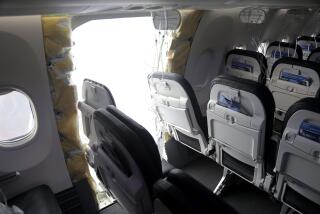Probe of Plane Crash Focuses on Propeller
RAISINVILLE TOWNSHIP, Mich. â Investigators are studying the possibility that the right propeller of a twin-engine commuter plane may have raced out of control in the seconds before the aircraft dived and crashed, killing all 29 aboard, a federal safety official said Sunday night.
National Transportation Safety Board member John Hammerschmidt, who heads the investigation of Thursdayâs crash of Comair Flight 3272, described evidence suggesting that the cockpit crew used emergency procedures to try to adjust the pitch of an errant propeller.
The NTSB is not ready to say what caused the crash, but Hammerschmidtâs remarks indicated that a malfunctioning propeller--or the cockpit crewâs reaction to it--could have been the culprit.
The Embraer 120 turboprop is equipped with twin propellers designed to spin at a constant speed. To climb, descend, accelerate or decelerate, a pilot changes the pitch of the propeller blades rather than the speed at which the propeller rotates.
Hammerschmidt said investigators are looking at evidence that suggests the control unit governing the speed of the right propeller may have failed, allowing the propeller to run wild and hurl the plane out of control.
He said switches and levers for three different control systems in the wrecked cockpit were found in positions that would have shut down the right engine, turned on its fire extinguishers and âfeatheredâ its propeller. Investigative sources said the cockpit crew probably threw the switches and moved the levers in a hasty effort to correct a problem. They said it seems unlikely that the crash would have moved that many switches and levers into corresponding positions.
In feathering a propeller, a pilot changes the pitch of the blades so they neither bite into the air to pull the plane along nor act as a pinwheel to slow the plane down.
Pilots normally feather propellers for two reasons: because of engine failure or a racing propeller.
Hammerschmidt said no evidence has been found that either engine failed or caught fire. On the other hand, information from the planeâs flight data recorder--one of two âblack boxesâ found in the wreckage--shows that the plane banked and turned sharply to the left before diving out of control. A turn to the left would be consistent with speeding of the right propeller.
Whether the apparent racing of the right propeller is the âeventâ that lab technicians say was revealed in sounds picked up by the cockpit voice recorder had not been determined, Hammerschmidt said.
He stressed again that any conclusion about what caused the plane to crash during a light snowstorm is still months away. Investigators are still considering whether a buildup of ice on the wings and fuselage could have led to the crash.
*
Shortly after noon Sunday, about a dozen members of the victimsâ families visited the crash site, a farm field beside the ice-encrusted banks of the Raisin River.
The visitors gathered in the bitter cold before a memorial built of hay bales that was erected about 150 yards from the impact point.
Propped in front of the hay bales was a blue-and-white sign: âIn memory of the passengers and crew of Comair Flight 3272, from the community of Monroe County and southeast Michigan.â
At the foot of the sign was a small bouquet of red carnations and babyâs breath.
While the visitors were there Sunday, about 30 investigators and recovery workers took a break in their third day of retrieving human remains from the site.
Morgan Countyâs chief medical examiner, David Lieberman, said it was hoped that the first victim identifications would be completed by today.
He predicted that virtually all the victims will be positively identified.
Lieberman said it appeared that all the victims died on impact.
More to Read
Sign up for Essential California
The most important California stories and recommendations in your inbox every morning.
You may occasionally receive promotional content from the Los Angeles Times.










